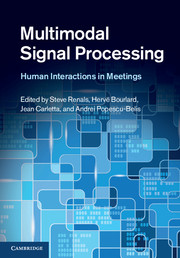Book contents
- Frontmatter
- Contents
- List of contributors
- 1 Multimodal signal processing for meetings: an introduction
- 2 Data collection
- 3 Microphone arrays and beamforming
- 4 Speaker diarization
- 5 Speech recognition
- 6 Sampling techniques for audio-visual tracking and head pose estimation
- 7 Video processing and recognition
- 8 Language structure
- 9 Multimodal analysis of small-group conversational dynamics
- 10 Summarization
- 11 User requirements for meeting support technology
- 12 Meeting browsers and meeting assistants
- 13 Evaluation of meeting support technology
- 14 Conclusion and perspectives
- References
- Index
11 - User requirements for meeting support technology
Published online by Cambridge University Press: 05 July 2012
- Frontmatter
- Contents
- List of contributors
- 1 Multimodal signal processing for meetings: an introduction
- 2 Data collection
- 3 Microphone arrays and beamforming
- 4 Speaker diarization
- 5 Speech recognition
- 6 Sampling techniques for audio-visual tracking and head pose estimation
- 7 Video processing and recognition
- 8 Language structure
- 9 Multimodal analysis of small-group conversational dynamics
- 10 Summarization
- 11 User requirements for meeting support technology
- 12 Meeting browsers and meeting assistants
- 13 Evaluation of meeting support technology
- 14 Conclusion and perspectives
- References
- Index
Summary
Many kinds of information technology can be used to make meetings more productive, some of which are related to what happens before and after meetings, while others are intended to be used during a meeting. Document repositories, presentation software, and even intelligent lighting can all play their part. However, the following discussion of user requirements will be restricted to systems that draw on the multimodal signal processing techniques described in the earlier chapters of this book to capture and analyze meetings. Such systems might help people understand something about a past meeting that has been stored in an archive, or they might aid meeting participants in some way during the meeting itself. For instance, they might help users understand what has been said at a meeting, or even convey an idea of who was present, who spoke, and what the interaction was like. We will refer to all such systems, regardless of their purpose or when they are used, as “meeting support technology.”
This chapter reviews the main methods and studies that elicited and analyzed user needs for meeting support technology in the past decade. The chapter starts by arguing that what is required is an iterative software process that through interaction between developers and potential users gradually narrows and refines sets of requirements for individual applications. Then, it both illustrates the approach and lays out specific user requirements by discussing the major user studies that have been conducted for meeting support technology.
- Type
- Chapter
- Information
- Multimodal Signal ProcessingHuman Interactions in Meetings, pp. 193 - 203Publisher: Cambridge University PressPrint publication year: 2012



